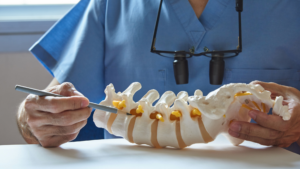Have you or a loved one been experiencing chronic pain for months in your lower body? If so, you may want to consider DRG Therapy, a new treatment method for chronic pain. This blog post explains what DRG Therapy is, who’s a good candidate for it, what you can expect from the treatment, and the next steps you can take.

DRG Therapy for Chronic Pain
What is DRG Therapy?
DRG Therapy stands for Dorsal Root Ganglion Stimulation therapy. According to Penn State Health, a dorsal root ganglion is a collection of sensory neurons at the dorsal root of a spinal nerve. DRGs act like traffic lights, managing the signals and sensations that travel along the spinal column to the brain.
DRG therapy is a type of neurostimulation therapy. This means using invasive and noninvasive techniques and the application of electrical stimulation to drive neural function. Stimulation can ease the pain in specific locations. DRG Therapy is for managing chronic pain in specific areas of the lower body like your:
- foot
- knee
- hip
- pelvis
- groin
While there isn’t a cure for isolated chronic pain, DRG therapy can provide some much-needed relief in those areas. It’s particularly beneficial for those who suffer from chronic pain in the pelvis and lower body.
Are You a Candidate?
You may want to consider DRG therapy if you’re experiencing:
- Chronic pain in a lower part of the body, like your foot, knee, hip, or groin after an injury or surgery.
- Chronic pain that lasts six months or more.
- Minimal or no relief from pain management therapies or traditional neurostimulation, medications, or surgery.
- Only partial relief from other therapies.
What Can You Expect from This Treatment?
The therapy involves a physician implanting a temporary and removable device, i.e., the DRG stimulator. The doctor will work with you to try out the device to see if it can effectively manage your pain before they implant it.
Once implanted, the physician uses a patient “remote control” to send mild electrical pulses from the stimulator to your dorsal root ganglia. The result should be pain relief in the targeted area.
Relieve Chronic Pain and Take Back Your Life
No one should live with continual, daily pain. DRG Therapy is unique because it’s a spinal stimulation concentrating on the lower body area. Relieve the pain so you can live the happy, productive life you deserve.
If you or a loved one has been experiencing chronic pain and are interested in DRG Therapy, Progressive Pain Management is here to help. In addition to DRG Therapy, we offer a wide variety of other pain management treatments and programs. Contact us today, and we’re happy to answer your questions about pain management and help you set up an appointment.
The Dorsal Root Ganglion (DRG) is a small bundle of nerves connected to each vertebra along your spine. The DRG is critical in processing pain signals and transmitting them to your brain. They have a particularly important role in how you experience pain. The DRG act as the body’s internal traffic light: they control when signals can enter the spinal cord, therefore allowing pain signals to travel to the brain.
The Dorsal Root Ganglion neurons modify your sensory perception (how you feel pain) before transmitting the signal to your spinal cord and central nervous system. This makes DRG stimulation an effective treatment approach for patients with chronic pain.

What is Dorsal Root Ganglion Stimulation?
Dorsal Root Ganglion stimulation utilizes a pulse generator that is implanted on the spine. The implant uses small electrical leads which are threaded into the epidural space where the DRG lies. The leads send a small electrical impulse to the area where the DRG is located. The impulses stimulate the Dorsal Root Ganglion to create a “red light.” This blocks pain signals from that specific area traveling to the brain.
The impulses either create a slight tingling sensation in the affected area, or has the ability to stop the pain altogether.
Benefits of DRG Stimulation
There are four specific benefits of targeting the Dorsal Root Ganglion for pain relief:
- Directed Targeting: Because the stimulator is implanted exactly where the pain is rooted, DRG stimulation can relieve pain in a specific area. The accuracy of this treatment has proven effective in 94.5% of patients who received targeted areas of pain.
- Low Energy: DRG stimulators use a tiny amount of energy – only about 10% of the energy that is required from a conventional spinal cord stimulator. The batteries in the DRG stimulator last longer because of the low energy requirement.
- Low Risk of Lead Migration: The DRG stimulators are tucked into a small space, limiting the chances of lead migration. There is reported less than 1% migration rate, whereas a traditional SCS reports an approximate 14% migration rate.
- Minimal Effects on Body Position: Due to the DRG’s location in the epidural space, the cerebrospinal fluid in between electrodes does not affect the patient’s posture or body position. The stimulation patterns remain constant regardless of any changes in the body’s position. Whether lying down, sitting down, standing, or walking, the patient receives the same pattern.
Your physician will first implant a trial DRG Stimulator using fluoroscopic guidance. Data is collected from this and evaluated to determine whether or not a permanent stimulator is beneficial.
If you think you are a good candidate for DRG Stimulation, fill out the form below. Someone from our team will get in touch!

